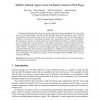381 search results - page 25 / 77 » Timing attacks on Web privacy |
SP
2010
IEEE
13 years 11 months ago
2010
IEEE
—Social networking sites such as Facebook, LinkedIn, and Xing have been reporting exponential growth rates. These sites have millions of registered users, and they are interestin...
INFOCOM
2009
IEEE
14 years 2 months ago
2009
IEEE
—In order to protect privacy, Radio Frequency Identification (RFID) systems employ Privacy-Preserving Authentication (PPA) to allow valid readers to explicitly authenticate their...
ACSAC
2008
IEEE
14 years 2 months ago
2008
IEEE
In its most general form, an attack signature is a program that can correctly determine if an input network packet sequence can successfully attack a protected network application...
CCS
2008
ACM
13 years 9 months ago
2008
ACM
Unrestricted information flows are a key security weakness of current web design. Cross-site scripting, cross-site request forgery, and other attacks typically require that inform...
CCS
2007
ACM
14 years 1 months ago
2007
ACM
We propose BeamAuth, a two-factor web authentication technique where the second factor is a specially crafted bookmark. BeamAuth presents two interesting features: (1) only server...

